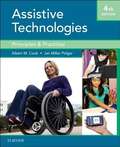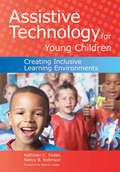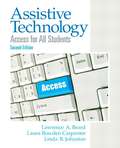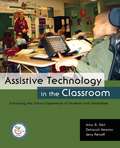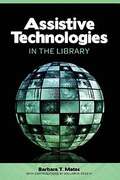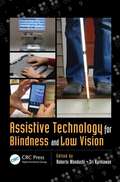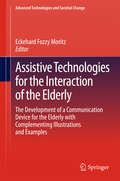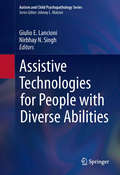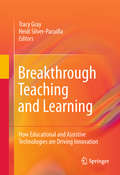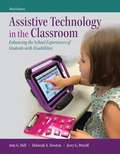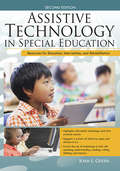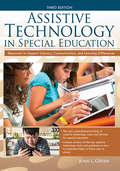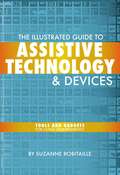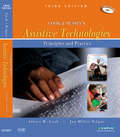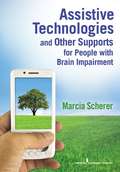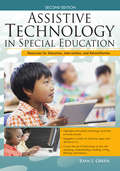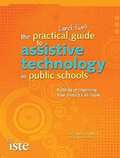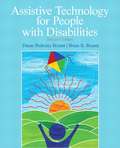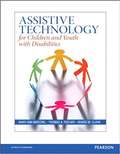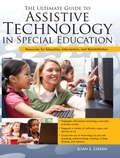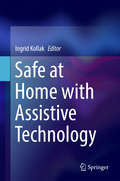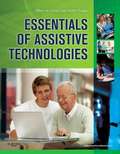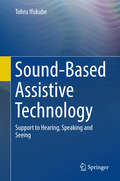Special Collections
Assistive Technology
Description: A diverse collection of textbooks detailing assistive technology for people with a diverse range of disabilities. #disability
- Table View
- List View
Assistive Technologies
by Albert M. Cook and Janice Miller PolgarIt's here: the latest edition of the one text you need to master assistive strategies, make confident clinical decisions, and help improve the quality of life for people with disabilities. Based on the Human Activity Assistive Technology (HAAT) model, Assistive Technologies: Principles and Practice, 4th Edition provides detailed coverage of the broad range of devices, services, and practices that comprise assistive technology, and focuses on the relationship between the human user and the assisted activity within specific contexts. Updated and expanded, this new edition features coverage of new ethical issues, more explicit applications of the HAAT model, and a variety of global issues highlighting technology applications and service delivery in developing countries. Human Activity Assistive Technology (HAAT) framework demonstrates assistive technology within common, everyday contexts for more relevant application. Focus on clinical application guides you in applying concepts to real-world situations. Review questions and chapter summaries in each chapter help you assess your understanding and identify areas where more study is needed. Content on the impact of AT on children and the role of AT in play and education for children with disabilities demonstrates how AT can be used for early intervention and to enhance development. Coverage of changing AT needs throughout the lifespan emphasizes how AT fits into people's lives and contributes to their full participation in society. Principles and practice of assistive technology provides the foundation for effective decision-making. NEW! Global issues content broadens the focus of application beyond North America to include technology applications and service delivery in developing countries. NEW! Ethical issues and occupational justice content exposes you to vital information as you start interacting with clients. NEW! More case studies added throughout the text foster an understanding of how assistive technologies are used and how they function. NEW! Updated content reflects current technology and helps keep you current. NEW! Explicit applications of the HAAT model in each of the chapters on specific technologies and more emphasis on the interactions among the elements make content even easier to understand.
Assistive Technology For Young Children
by Nancy B. Robinson and Kathleen Curry SadaoThis book appeals to the needs of a wide range of readers who seek to increase their technology competencies in order to improve access to learning for children with disabilities.
Assistive Technology
by Lawrence A. Beard and Linda B. Johnston and Laura Bowden CarpenterOrganized around the theme of universal design, this guide to assistive technology discusses the knowledge and skills educators need to know in order to determine the appropriate use of technology and services to meet the needs of individuals with disabilities. The text provides an overview and introduction to the topic of assistive technology, evaluating various technologies for classroom use, and using assistive technology with special needs students of a diverse range of disabilities, including the young child with special needs, students with high incidence disabilities, positioning and mobility for students with physical disabilities, students with communication disorders, and sensory impairments. It further discusses AT in relation to transitioning, distance learning, and the ethical standards of practice. The new edition has been thoroughly updated to reflect the most recent AT beneficial to students requiring such special accommodations, including links to websites of current AT devices, and software for use in the classroom, and a new chapter on Universal Design for Learning and Response to Intervention and how to combine the two techniques to provide students with access to the general education curriculum. This edition also features more on ethics and assistive technology use for consideration of all students, new chapter introductions, questions for reflection, end-of-chapter review material, and extended coverage of diversity related to assistive technology and the classroom. Designed to provide useful information and strategies for candidates in teacher education programs and those practicing educators, the book is also useful to and any other professional or layperson interested in assistive technology and learning for all students.
Assistive Technology in the Classroom
by Amy G. Dell and Deborah A. Newton and Jerry G. PetroffWith an emphasis on the integration of assistive technology into the curriculum, this text focuses on how assistive technology can be used in schools to enhance the teaching and learning of students with disabilities.
Assistive Technologies In The Library
by Barbara T. Mates and William R. Reed IvThis sensitively written and practical guidebook will be an indispensable resource for ensuring that a library’s offerings are accessible to everyone.
Assistive Technology For Blindness And Low Vision
by Roberto Manduchi and Sri KurniawanAssistive technology has made it feasible for individuals with a wide range of impairments to engage in many activities, such as education and employment, in ways not previously possible. The key factor is to create consumer-driven technologies that solve the problems by addressing the needs of persons with visual impairments. Assistive Technology for Blindness and Low Vision explores a broad range of technologies that are improving the lives of these individuals. Presenting the current state of the art, this book emphasizes what can be learned from past successful products, as well as what exciting new solutions the future holds.
Written by world-class leaders in their field, the chapters cover the physiological bases of vision loss and the fundamentals of orientation, mobility, and information access for blind and low vision individuals. They discuss technology for multiple applications (mobility, wayfinding, information access, education, work, entertainment), including both established technology and cutting-edge research. The book also examines computer and digital media access and the scientific basis for the theory and practice of sensory substitution.
This volume provides a holistic view of the elements to consider when designing assistive technology for persons with visual impairment, keeping in mind the need for a user-driven approach to successfully design products that are easy to use, well priced, and fill a specific need. Written for a broad audience, this book provides a comprehensive overview and in-depth descriptions of current technology for designers, engineers, practitioners, rehabilitation professionals, and all readers interested in the challenges and promises of creating successful assistive technology.
Assistive Technologies for the Interaction of the Elderly
by Eckehard Fozzy MoritzThis book presents a wealth of insights and new conceptualizations for the development of Assistive Technologies for the Interaction of the Elderly. The book arranges the chapters according to important aspects of maximizing the use value in innovation projects. Every chapter will include an executive summary reporting the main results, a storyline using everyday language, and scientific excursions, wherever useful. The book shows how an innovation project should be structured towards maximum use value and how a project should be structured in order to make a difference. It describes the useful categorization of the large group of the elderly to maximize the focus of the innovation and demonstrates the user involvement into innovation activities. Of course, the assessment of such innovative projects is discussed as well as the "lessons learned". The book also explores the business opportunities and the financial evaluation of aspects of assistive technology.
Assistive Technologies for People with Diverse Abilities
by Nirbhay N. Singh and Giulio E. LancioniThe familiar image of the disabled tends to emphasize their limitations and reduced quality of life. However, many people with cognitive, motor, and other difficulties also have the capacity to enhance their social interactions, leisure pursuits and daily activities with the aid of assistive technology. Assistive devices from the simple to the sophisticated, have become essential to intervention programs for this population. And not surprisingly the numbers of devices available are growing steadily. Assistive Technologies for People with Diverse Abilities offers expert analysis of pertinent issues coupled with practical discussion of solutions for effective support. Its comprehensive literature review describes current and emerging devices and presents evidence-based guidelines for matching promising technologies to individuals. Program outcomes are assessed, as are their potential impact on the future of the field. In addition, chapters provide detailed descriptions of the personal and social needs of the widest range of individuals with congenital and acquired conditions, including: Acquired brain damage. Communication impairment. Attention and learning difficulties (with special focus on college students). Visual impairment and blindness. Autism spectrum disorders. Behavioral and occupational disorders. Alzheimer's disease. Severe, profound and multiple impairments. The scope and depth of coverage makes Assistive Technologies for People with Diverse Abilities an invaluable resource for researchers, professionals and graduate students in developmental psychology, rehabilitation medicine, educational technology, occupational therapy, speech pathology and clinical psychology.
Breakthrough Teaching and Learning
by Tracy Gray and Heidi Silver-PacuillaThe many technology-related educational changes of the past decade have been propelled by even greater changes in the general consumer technology landscape. Education has become increasingly entwined with the digital consumer landscape. We are no longer asking whether digital materials and tools should be integrated into teaching and learning, but how and how well. Meanwhile, the overall academic performance of U.S. students has not kept pace with our international peers. Many policymakers have called for increased attention to students' 21st century skills and work readiness, pointing to the critical role technology should play in educational innovation. These changes mean that many mainstream accessible technologies can be used in the classroom to benefit a diverse population of learners, including students with disabilities and English language learners, reflecting the national shift from separate special education programs to more inclusive classrooms. Changes to policies and standards have pushed assistive and accessible technologies to the forefront, including the Higher Education Opportunity Act of 2008, which requires teacher preparation programs to address educational technology and principles of universal design for learning (UDL), and the National Instructional Materials Accessibility Standard (NIMAS), which creates a public-private infrastructure to provide more timely delivery of digital text to students with physical and print disabilities. This volume represents pioneering ideas that examine how accessible educational technologies can be harnessed for breakthrough learning for all students. Chapters will cover innovation trends in educational and assistive technologies, cognitive and neuroscience findings on how individual differences impact technology use and choice; the intersection of educational, leisure, health habits and exer-gaming; the use of social networking tools by students with and without disabilities; the use of social networking for teacher professional learning communities; the future of assessments for decision-making; and an analysis of the habits of mind and work traits of innovators NCTI has interviewed over the past five years.
Assistive Technology in the Classroom
by Amy G. Dell and Deborah A. Newton and Jerry G. PetroffWith an emphasis on the integration of assistive technology into the curriculum, this text focuses on how assistive technology can be used in schools to enhance the teaching and learning of students with disabilities. This link between technology and teaching and learning drives the book's organization as well as its content. It is organized by school-related tasks that students must perform on a daily basis to be successful -- reading, writing, practicing academic skills, and communicating with their teachers and peers – and presents descriptions of technology-based solutions to the obstacles students with disabilities face in completing these tasks. Since being able to access computers is one major barrier, the text features a section on making computers accessible to students with a wide range of disabilities. A companion web site offers up-to-date information on product names, vendors, web site addresses, and other time-sensitive material.
Assistive Technology In Special Education
by Joan GreenFamilies, teachers, and therapists who are searching for an update about how to use the latest technologies to help individuals who struggle with communication, literacy, and learning will benefit from the wealth of practical, well-organized information in this second edition of Assistive Technology in Special Education. The indexed update presents an overview of the uses of technologies to help readers zero in on specific, powerful, cutting-edge resources they can use to enhance success. The book features new tools to improve and compensate for challenges relating to speaking, understanding, reading, writing, thinking and remembering, as well as strategies to help students become more organized and efficient. The use of tablets such as the iPad and smartphones, as well as cloud-based products, are highlighted. Online resources and social networking tools are presented to empower readers to learn about new products as they become available.
Assistive Technology in Special Education
by Joan GreenAssistive Technology in Special Education presents a wealth of practical, well-organized information to help families, teachers, and therapists find effective solutions for students with learning, literacy, and cognitive challenges. This third edition features new affordable tools to improve and compensate for challenges related to speaking, understanding, reading, writing, and thinking and remembering, as well as strategies to help students become more organized and efficient. Also highlighted are iDevices, G Suite (Google Apps and Extensions), online collaborative sites, and features built into the computers and mobile devices readers already use. As technology changes and new operating systems make older programs obsolete, this book will empower readers to explore the most current resources as they become available.
The Illustrated Guide to Assistive Technology and Devices
by Suzanne Robitaille"A Doody's Core Title 2012"This new illustrated guide to assistive technologies and devices chronicles the use of AT/AD - technology used by individuals with disabilities to perform functions that might otherwise be difficult or impossible. This book empowers people to use assistive technologies to overcome some of their physical or mental limitations and have a more equal playing field. It includes real-life examples about how people with disabilities are using assistive technology (AT) to assist them in daily tasks, and discusses emotional issues related to AT/AD.
Cook and Hussey's Assistive Technologies
by Albert M. Cook and Janice Miller PolgarMaster the assistive strategies you need to make confident clinical decisions and help improve the quality of life for people with disabilities with the latest edition of this comprehensive text. Based on the Human Activity Assistive Technology (HAAT) model developed by the authors, the book provides detailed coverage of the broad range of devices, services, and practices that comprise assistive technology and focuses on the relationship between the human user and the assisted activity within specific contexts. This new edition has been expanded and updated, and features new multimedia components that further demonstrate how to apply the concepts you've learned to real-world practice. Focus on clinical application guides you in applying concepts to real-world situations. Human Activity Assistive Technology (HAAT) framework demonstrates assistive technology within common, everyday contexts for more relevant application. Review questions and chapter summaries in each chapter help you assess your understanding and identify areas where more study is needed. Assistive Technology for Cognitive Augmentation chapter gives you a foundation in the growing use of assistive technology to enhance human cognitive processes. Technologies that Aid Transportation familiarizes you with the many options of transportation assistance available and helps you determine which are right for your clients. Separate chapters on sensory aid for visual and auditory impairment provide additional strategies in these key assistive areas. Bound-in companion CD-ROM features videos of assessment and device use that helps you visualize procedures and reinforce your clinical application skills. Evolve resources test your understanding of terms and concepts and link you to supplemental sources for further research. Additional case studies throughout the text prepare you for practice with realistic client scenarios. Expanded evidence-based content supports concepts with real-world research data. Additional photographs, illustrations, tables, and boxes provide clear visual references and quick access to important information.
Cook and Hussey's Assistive Technologies
by Albert M. Cook and Janice Miller PolgarMaster the assistive strategies you need to make confident clinical decisions and help improve the quality of life for people with disabilities with the latest edition of this comprehensive text. Based on the Human Activity Assistive Technology (HAAT) model developed by the authors, the book provides detailed coverage of the broad range of devices, services, and practices that comprise assistive technology and focuses on the relationship between the human user and the assisted activity within specific contexts. This title includes additional digital media when purchased in print format. For this digital book edition, media content may not be included
Assistive Technologies and Other Supports for People With Brain Impairment
by Marcia J. SchererAssistive Technologies and Other Support for People with Brain Impairment, by Marcia J. Scherer, is a must-have text for academic instructors and their students. The author's synopsis of brain impairment, current rehabilitation strategies, available assistive technologies and resources, as well as the practical merging of the above, makes this an invaluable addition to any academic program in cognitive rehabilitation. This book gives a clear and detailed overview of how the brain reacts to impairment and gives illustrated examples of effective integration of AT into the lives of people with cognitive disability. Integrating current research with the experiences of people with cognitive disabilities, this volume examines how assistive and cognitive support technologies are being harnessed to provide assistance for thinking, remembering, and learning. The book vividly describes real-life situations in which cognitively impaired individuals use assistive supports and the advantages and limitations these individuals perceive from their use. It provides information on how cognitively impaired individuals and their families and caregivers can select the most appropriate technologies from a wide array of accommodations and resources, including individualized protocols of different forms of support to facilitate optimal functioning. The text offers practitioners a comprehensive and systematic process for ensuring their clients' effective application and utilization of this technology. This book will also provide insight for users of assistive technology and their families and caregivers to ensure optimal technology use.
Assistive Technology in Special Education
by Joan GreenFamilies, teachers, and therapists who are searching for an update about how to use the latest technologies to help individuals who struggle with communication, literacy, and learning will benefit from the wealth of practical, well-organized information in this second edition of Assistive Technology in Special Education. The indexed update presents an overview of the uses of technologies to help readers zero in on specific, powerful, cutting-edge resources they can use to enhance success. The book features new tools to improve and compensate for challenges relating to speaking, understanding, reading, writing, thinking and remembering, as well as strategies to help students become more organized and efficient. The use of tablets such as the iPad and smartphones, as well as cloud-based products, are highlighted. Online resources and social networking tools are presented to empower readers to learn about new products as they become available.
The Practical (and Fun) Guide to Assistive Technology in Public Schools
by Christopher R. Bugaj and Sally Norton-DarrAssistive technology (AT) is a serious topic, but reading about it doesn't have to be boring! In this essential reference, authors Christopher R. Bugaj and Sally Norton-Darr throw in a few pirates, monsters, and monkeys to keep you engaged but don't sacrifice the tips, strategies, and insight that will help improve your school or district AT program. From setting up a stellar team to consultations and evaluations, and from implementation to assessing success, this guide presents detailed advice and ideas to provide AT services that effectively and efficiently help students. The nuts and bolts of each area are presented in a practical way (with amusing metaphors thrown in for good measure) so that you can directly apply what's in the book and see tangible results. Educators new to AT will find the step-by-step layout help in building an AT team and procedures, while seasoned AT professionals will find value in the fresh ideas on reducing paperwork, expanding an AT team, and strategies for considering AT for all students. Christopher R. Bugaj, an assistive technology trainer, is a founding member of the AT team for Loudoun County Public Schools in Virginia. He also works as an adjunct professor for George Mason University and is the host and producer of the award-winning podcast series A.T. TIPS cast. Sally Norton-Darr is an assistive technology trainer for Loudoun County Public Schools and a nationally certified speech-language pathologist. She presents on high- and low-tech AT topics both nationally and regionally. AUDIENCE: Administrators (K-12), assistive technology professionals, special education staff. FEATURES: Guides AT professionals through the steps of setting up a successful AT program. Information on AT, IEPs, and the law. Advice and ideas for working successfully with all stakeholders, including teachers, parents, service providers, IEP teams, and students. TECHNOLOGY: This material is suitable for any platform.
Assistive Technology For People With Disabilities (Second Edition)
by Diane Pedrotty Bryant and Brian R. BryantAssistive Technology for People with Disabilities, Second Edition, includes eight comprehensive chapters that focus on devices and software to enhance the lives and promote the independence of people with disabilities. Updated with new research, content and features to address current developments in the field, the book approaches assistive technology and education in a lifespan, multidisciplinary manner by discussing the use of current technology in the fields of special education, rehabilitation, speech-language pathology, and other disciplines. Featured devices and software will help you understand how areas such as mobility, communication, education, independent living, and access to information media affect learning and living for individuals with disabilities. You will also gain a great understanding of the foundational and historical perspectives of AT, assessment, universal design, and the ADAPT framework, which is a tool to help educators make decisions about appropriate AT, student needs, and the demands of the environment. Developed from the authors' years of experience teaching both K-12 students and adults, as well as their own framework for understanding assistive technology application and integrating technology into instruction, this new edition addresses assistive technology that promotes knowledge and skills, practical application and a myriad of opportunities that good technology provides for persons with disabilities.
Assistive Technology For Children And Youth With Disabilities
by Mary Ann Marchel and Denise M. Clark and Thomas A. FischerEncompassing home, school and community environments, Assistive Technology for Children and Youth with Disabilities highlights the vast amount of supports available for children with disabilities from birth to age 21. An informative resource, the text details not only what types of assistive technology exist, but also how to select technology to meet specific students needs and match specific environmental circumstances. Chapters address the broad range of technologies now available, including supports for mobility, positioning, access, academic areas, behavior problems, recreation, and transitioning. Case examples, vignettes and activities provide practical, real-life examples that show how to use assistive technology to improve the independence and participation of students with special needs.
The Ultimate Guide to Assistive Technology in Special Education
by Joan L. GreenGreen, a speech-language pathologist, presents a guide for parents, teachers, therapists, and others to using assistive technology in special education classrooms to improve the communication, literacy, and learning of students with disabilities. After introducing computers and software and the benefits of this technology, she outlines specific tools for verbal and written expression, auditory and reading comprehension, reading skills, cognition, learning, and memory, with information on websites, features, operating systems, and price. She includes games and free online interactive activities, Internet communication and learning tools, and adapted email, search engines, and web browsers. There is no index. Annotation ©2011 Book News, Inc. , Portland, OR (booknews. com)
Safe at Home with Assistive Technology
by Ingrid KollakThis book describes how assistive technology can help handicapped, elderly and acutely sick people to manage their daily lives better and stay safe in the home. It discusses how safety is understood from an ethical, technical and social perspective, and offers examples of the problems that users, their helpers and professional carers have with assistive technology in everyday situations. The book provides insights from user-centred research and uses photographs to illustrate the main topic: how users and technology can work together to ensure safety. User-focused and combining experience with research, the book will interest users of these kinds of technology, health professionals who might introduce and/or prescribe them, engineers who develop and sell assistive technological gadgets, and architects who build safe homes - as well as researchers and students who work in these fields. It provides an overview of the existing technology, examines ways to test its effectiveness from the point of view of users, health professionals and researchers from different fields (architecture, education, engineering, facility management, medicine, nursing, occupational therapy, rehabilitative medicine, physiotherapy, social science and speech therapy), and lists useful addresses, websites and literature
Safe at Home with Assistive Technology
by Ingrid KollakThis book describes how assistive technology can help handicapped, elderly and acutely sick people to manage their daily lives better and stay safe in the home. It discusses how safety is understood from an ethical, technical and social perspective, and offers examples of the problems that users, their helpers and professional carers have with assistive technology in everyday situations. The book provides insights from user-centred research and uses photographs to illustrate the main topic: how users and technology can work together to ensure safety. User-focused and combining experience with research, the book will interest users of these kinds of technology, health professionals who might introduce and/or prescribe them, engineers who develop and sell assistive technological gadgets, and architects who build safe homes – as well as researchers and students who work in these fields. It provides an overview of the existing technology, examines ways to test its effectiveness from the point of view of users, health professionals and researchers from different fields (architecture, education, engineering, facility management, medicine, nursing, occupational therapy, rehabilitative medicine, physiotherapy, social science and speech therapy), and lists useful addresses, websites and literature
Essentials of Assistive Technologies
by Albert M. Cook and Jan Millar PolgarMaster the assistive strategies you need to make confident clinical decisions and help improve the quality of life for people with disabilities with this new essentials text. Based on the Human Activity Assistive Technology (HAAT) model developed by Dr. Cook, the book provides the most important coverage of the devices, services, and practices that comprise assistive technology and focuses on the relationship between the human user and the assisted activity within specific contexts. Case studies, illustrations of assistive devices, review questions, and well-developed learning objectives help you focus on the most important areas of assistive technology application.
Sound-Based Assistive Technology
by Tohru IfukubeThis book presents a technology to help speech-, hearing- and sight-impaired people. It explains how they will benefit from an enhancement in their ability to recognize and produce speech or to detect sounds in their surroundings. Additionally, it is considered how sound-based assistive technology might be applied to the areas of speech recognition, speech synthesis, environmental recognition, virtual reality and robots. The primary focus of this book is to provide an understanding of both the methodology and basic concepts of assistive technology rather than listing the variety of assistive devices developed. This book presents a number of different topics which are sufficiently independent from one another that the reader may begin at any chapter without lacking background information. Much of the research quoted in this book was conducted in the author's laboratories at Hokkaido University and University of Tokyo. This book offers the reader a better understanding of a number of unsolved problems that still persist in the field of sound-based assistive technology.
